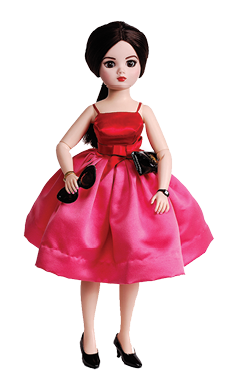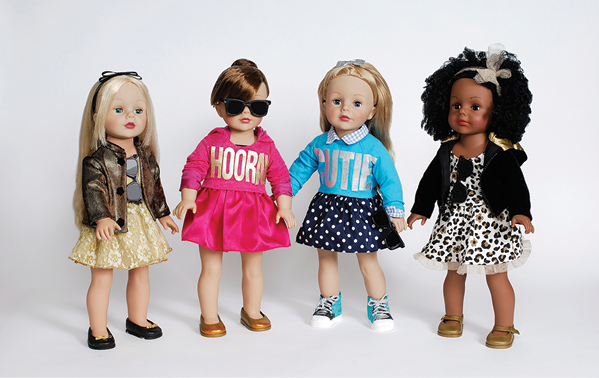


![]()
ONLINE

The Doll Authority
Editors’ Note
Gale Jarvis started her career with R.H. Macy’s in New York City as Vice President of Merchandise and, in 1985, Jarvis joined FAO Schwarz. She then joined The Madame Alexander Doll Company in 1998, where she has been President. Jarvis received her B.A. from Oklahoma State University and completed the Executive Business Training Program at Babson College.
Company Brief
Based out of New York City, The Madame Alexander Doll Company (madamealexander.com) designs, manufactures, and distributes play, baby, and collectible dolls, and represents “Best in Class” for the doll business. Beatrice Alexander Behrman founded the company in 1923 with the mission to stimulate girls’ imaginations through their emotional attachments and play patterns with a doll. In 2012, Kahn Lucas acquired the Alexander Doll Company.
What is the heritage of the The Madame Alexander Doll Company?
We were founded in 1923 by Beatrice Alexander, who grew up in a home over her father’s doll hospital and used to see kids walk in with primarily broken porcelain dolls. She had a dream to build a doll someday that would not break.
She started making cloth dolls with her sisters and then developed a plastic compound to make the first plastic doll in the business with eyes that opened and closed. We still make some of the dolls in our collectible line that she created.
There is a long heritage based on quality and 91 years of doll-making that puts us in a position as the doll authority.
People perceived it to be so special that it evolved into a collectible, but now the play-doll business is the largest business for both our future and our current direction.

Madame Alexander’s
“Isaac Mizrahi Modern Iconic
- Limited Edition” doll
Has the process of doll-making changed?
Some dolls still have a very handcrafted feel. We make play dolls and baby dolls that are part of play activity, and we maintain our collectible and high-end couture business.
All of the high-end couture business is a lot of handiwork – like beading on the clothing or face painting.
When you get into play, because of child safety standards across the toy industry, some of our processes have changed because we have to address the safety issues with children. Everything is designed based on our ages and stages, focusing on fun and nurturing play. We have dolls appropriate for newborn babies and little girls, and Collection Dolls for 4-up-to-14 in play, then from 14 on they become more adult-driven because they include small parts.
We abide by all the rules. For instance, the eyelashes have to sustain 15 pounds of pull test, so we make them in an innovative way.
But a lot of our artistry and sculpting is the same, and we continue to improve in terms of quality.
At your price points, do you have target markets at all levels?
In addition to ages and stages, we have an age-appropriate doll from infant through every year of a person’s life.
We also have channels. Within those channels, we sell to real play stores; we sell to Walmart and Target, and then all specialty stores, and we do a lot of Web-directed business.
We sell to every channel within the retail industry but in all forms, so our price points are anywhere from $10 to $1,500.

18-inch play dolls from the Issac Mirzrahi Collection
will be available November 2014
How significant is the Web business when there is such a strong touch-and-feel aspect to this type of sale?
Our site is the voice of the company. There is an area where people like to look at things and see how they feel, because of the quality and aesthetic value.
Often, when people buy a doll, it is aspirational – a child will look at an older girl and what they aspire to be. It could be a mom or a collector that says the doll spoke to them – it looked like their niece or little girl, or reminded them of themselves. It could be something nostalgic – this plays a part in the toy business.
For a brand with such recognition and loyalty, is there an opportunity to expand into other areas?
We can venture into new categories with the name. We do it now. We make doll accessories and pets for our dolls. The brand is fantastic and it’s a fabulous name.
What sparked the partnership with Isaac Mizrahi?
We continue to have collaborations like this. Jason Wu has designed dolls for us. It’s fun, and it keeps things relevant and fresh. Fashion is a large part of the business, be it on a fashion doll or a baby doll. What the doll is wearing is very relevant, and from our origins in 1923 onward you can almost follow pop culture through the dolls and what they were wearing. It closely follows the history of our country.
We do a whole line of dolls of women through the years who have made big contributions to our society. This year, we have in our line Nellie Bly and Ada Lovelace, as well as Mata Hari. The dolls come with a history card telling what these people did and the differences they made in society. We do international personalities too and have done that since the early ’50s. We just made a line of international play dolls that will retail for $15 to $18, and they will be found in a greater number of stores; they are more playable than collectible.
Will there always be a need for brick-and-mortar stores in the future?
Brick-and-mortar will always be required because people enjoy shopping and looking at things. Dolls aren’t always in demand, so customers like to look at them and be inspired by them.
The Web, however, especially in areas where people don’t have access to a store, is ideal for those that want to review a range of different things; it plays an important part and will continue to grow. We also can describe things differently online and talk more as a company about our mission and direction. So there are some important aspects of our voice speaking to the consumer, but there is also a need for a store.
How has the acquisition by Kahn Lucas in 2012 impacted you?
Our consumer is the same – a girl, a mother, or a relative. Kahn Lucas makes dresses and all kinds of ready-to-wear apparel for girls from zero to pre-teen. So there is a huge dynamic where we’re addressing the same consumer, meaning we have a lot of synergies between us. We make dolls that match the Kahn Lucas outfits. So we can sell a doll and a matching dress. We have a similar mission and objective so it has worked well.
When you joined the company in 1998, what excited you about the opportunity?
I grew up playing with Alexander dolls. Then I started at Macy’s and I had toys under my supervision. I worked for FAO Schwarz and they were one of Alexander’s first customers. So there has always been a link to toys for me.•